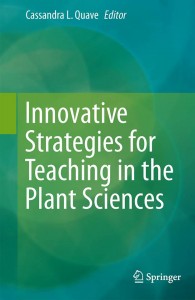 My edited volume, Innovative Strategies for Teaching in the Plant Sciences is in production, with an anticipated release date in March 31, 2014! Visit the publisher website to pre-order the book!
My edited volume, Innovative Strategies for Teaching in the Plant Sciences is in production, with an anticipated release date in March 31, 2014! Visit the publisher website to pre-order the book!
ABOUT THE BOOK:
- Chapters will provide various creative ways to engage students in the plant sciences, including the use of ethnobotany to relate cultural impact worldwide
- Chapters will be contributed by leaders in the field
- Affordable and accessible in content for teachers and botany specialists alike
Innovative Strategies for Teaching in the Plant Sciences focuses on innovative ways in which educators can enrich the plant science content being taught in universities and secondary schools. Drawing on contributions from scholars around the world, various methods of teaching plant science is demonstrated. Specifically, core concepts from ethnobotany can be used to foster the development of connections between students, their environment, and other cultures around the world. Furthermore, the volume presents different ways to incorporate local methods and technology into a hands-on approach to teaching and learning in the plant sciences.
Written by leaders in the field, Innovative Strategies for Teaching in the Plant Sciences is a valuable resource for teachers and graduate students in the plant sciences.
Content Level » Professional/practitioner
Keywords » Biology – Botany – Education – Ethnobotany – Plant sciences
Related subjects » Ecology – Learning & Instruction – Plant Sciences – Science Education
TABLE OF CONTENTS:
Part I. Defining the Needs of Educators and Students
Chapter 1. Carrying Plant Knowledge Forward in the USA
Patricia Harrison
Chapter 2. Lessons Learned in Development of an Interdisciplinary Science Curriculum Support Organization
Will McClatchey and K.W. Bridges
Chapter 3. The Contribution of Ethnobiology to Teaching Plant Sciences: Student and Faculty Perspectives
Sofia A. Vougioukalou, Keri Barfield, Ryan D. Huish, Laura Shiels, Sunshine L. Brosi, and Patricia Harrison
Chapter 4. From Learning to Teaching: Bridging Students’ Experience and Teachers’ Expectations
Valentina Savo and Ursula M. Arndt
Part II. Introducing Fundamental Skills
Chapter 5. Research-Based Learning
Gail E. Wagner
Chapter 6. Aligning Plant Identification Curricula to Disciplinary Standards Through the Framework of Student-Centered Learning
Sunshine L. Brosi and Ryan D. Huish
Chapter 7. Cultivation of Local Botanical Knowledge or Knowledge of Nature Using Interdisciplinary, Innovative, and Mind/Brain-Based Techniques
Karen C. Hall and April T. Sawey
Part III. Connecting Students to Plants
Chapter 8. “What’s That Called?” Folk Taxonomy and Connecting Students to the Human-Nature Interface
Nanci J. Ross
Chapter 9. Learning from the Land: Incorporating Indigenous Perspectives into the Plant Sciences
Michael Benedict (Mohawk), Kelly Kindscher, and Raymond Pierotti
Chapter 10. Pedagogy and Botany of the Columbian Biological Exchange: The 1491 Meal
John Richard Stepp
Chapter 11. Teaching Plant Science in School and Community Settings
Lisa Carolina Gonzalez
Chapter 12. Using Community Resources for Ethnobotany Courses
Al Keali‘i Chock
Part IV. Teaching Through Field Experiences
Chapter 13. Learning in Paradise: The Role of Botanic Gardens in University Education
Bradley C. Bennett
Chapter 14. Teaching Ethnobotany Through Field Research: A Case Study Integrating Conservation with Tibetan Traditional Ecological Knowledge
Jan Salick
Chapter 15. Excursions in Teaching Plant Science Through the Local Ethnobotany of the Food-Medicine Continuum: Field Trips to Traditional Specialty Food Markets
Cedric Barrett Baker and Gokhan Hacisalihoglu
Chapter 16. Ecosystem Excitement: Using Everyday Items, Projects, Field Trips, and Exotic Images to Connect Students to Plants
Maria Fadiman
Part V. Integrating Technology
Chapter 17. Teaching Ethnobiology Online at a Canadian Distance Learning University
Leslie Main Johnson and Janelle Marie Baker
Chapter 18. Linking Student Skill-Building with Public Outreach and Education
Cassandra L. Quave






